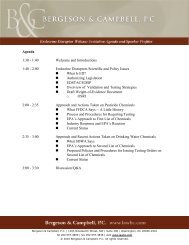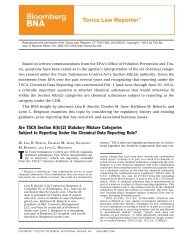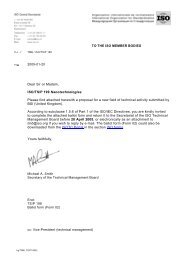TSCA Section 8(b) - Bergeson & Campbell, P.C.
TSCA Section 8(b) - Bergeson & Campbell, P.C.
TSCA Section 8(b) - Bergeson & Campbell, P.C.
- No tags were found...
You also want an ePaper? Increase the reach of your titles
YUMPU automatically turns print PDFs into web optimized ePapers that Google loves.
2<strong>TSCA</strong> statutory definition of chemical substance. 3<strong>TSCA</strong> does not regulate products per se, but insteadregulates the chemical components that may constituteproducts, unless expressly excluded in the statutorydefinition of chemical substance.<strong>TSCA</strong> <strong>Section</strong> 8(b)(1) directs EPA to ‘‘compile, keepcurrent, and publish a list of each chemical substancewhich is manufactured or processed in the UnitedStates.’’ 4 This list is known as the <strong>TSCA</strong> Chemical SubstanceInventory (<strong>TSCA</strong> Inventory or Inventory). <strong>TSCA</strong><strong>Section</strong> 8(b)(2) states: ‘‘To the extent consistent withthe purposes of this [Act], the Administrator may, inlieu of listing, pursuant to paragraph (1), a chemicalsubstance individually, list a category of chemical substancesin which such substance is included.’’ 5 <strong>Section</strong>26(c)(1) discusses the concept of ‘‘categories’’ moregenerally under <strong>TSCA</strong> and clarifies that ‘‘[a]ny actionauthorized or required . . . under any provision of this[Act] with respect to a chemical substance’’ may betaken ‘‘in accordance with that provision with respect toa category of chemical substances.’’ 6 <strong>Section</strong> 26(c)(2)goes on to state that ‘‘[t]he term ‘category of chemicalsubstances’ means a group of chemical substances themembers of which are similar in molecular structure, inphysical, chemical, or biological properties. . . . ’’ 7 Interestingly,<strong>Section</strong>s 8(b)(2) and 26(c) are the only <strong>TSCA</strong>provisions where the category authority is specificallyenumerated.The initial Inventory reporting rules were publishedon Dec. 23, 1977. 8 EPA identified six statutory chemicalcategories under its <strong>Section</strong> 8(b)(2) authority when theInventory was first established, with some input fromindustry. 9 They are:s Cement, Portland, Chemicals (CASRN 65997-15-1)s Cement, Alumina, Chemicals (CASRN 65997-16-2)s Glass, Oxide Chemicals (CASRN 65997-17-3)s Frits, Chemicals (CASRN 65997-18-4)s Steel Manufacture, Chemicals (CASRN 65997-19-5)s Ceramic Materials and Wares, Chemicals (CASRN66402-68-4)Once the Inventory was created, those chemical substanceson the Inventory were referred to as ‘‘existing’’chemical substances. ‘‘New chemical substance’’ refersto any chemical substance not listed on the <strong>TSCA</strong> Inventory.10 Under the authority of <strong>TSCA</strong> <strong>Section</strong> 5, EPArequires companies to submit premanufacture notifications(PMN) before the commercial manufacture or importationof ‘‘new’’ chemical substances. Accordingly,the Inventory establishes the <strong>TSCA</strong> regulatory status ofand requirements on new versus existing chemical substances.The Inventory is thus critically important forcompanies and other regulated entities to knowwhether chemical substances commercially manufacturedor imported are listed on the Inventory, either individuallyunder <strong>Section</strong> 8(b)(1) or because they arepart of a ‘‘category of chemical substances’’ under <strong>Section</strong>8(b)(2), or are new chemical substances subject to<strong>Section</strong> 5 requirements.EPA has in the more recent past indicated that it intendsto publish a ‘‘clarification’’ notice in the FederalRegister for comment, in which EPA will clarify ‘‘theguidance on chemical identification of certain statutorymixtures for purposes of the . . . <strong>TSCA</strong> Inventory.’’ EPAstated that ‘‘[f]or the initial reporting period that establishedthe <strong>TSCA</strong> Inventory, EPA developed broad listingcriteria (‘category listings’) for the complex reactionproducts known as statutory mixtures’’ and that EPAwill clarify which chemical substances comprise complexreaction products that fall under the <strong>TSCA</strong> <strong>Section</strong>8(b)(2) ‘‘category listings’’ and those chemical substances‘‘not currently on the <strong>TSCA</strong> Inventory’’ wouldbe considered to be new chemical substances under<strong>TSCA</strong> and thus subject to notification under <strong>TSCA</strong> <strong>Section</strong>5. The <strong>TSCA</strong> Inventory status of the chemical substancescontained in these six categories is thus a significantissue to be resolved.Another important and uniquely pressing issue thatEPA’s ‘‘clarification,’’ and any potential change inpolicy, may raise concerns the reporting requirementsthat may apply to these chemical substances. It is importantto note that the six statutory mixture categoriesare composed of inorganic chemicals. Although inorganicchemicals had been fully exempted from InventoryUpdate Rule (IUR) reporting commencing with theinitial reporting in 1986, EPA amended the reporting requirementsin 2003, in part to phase-in reporting for inorganicchemicals beginning with the 2006 IUR. Inorganicchemicals are also now subject to somewhat expartof a mixture is subject to these reporting regulations. Thisexclusion applies only to the mixture and not to the chemicalsubstances of which the mixture is comprised. The term ‘‘mixture’’includes alloys, inorganic glasses, ceramics, frits, and cements,including Portland cement.’’3 Mixtures may be subject to <strong>TSCA</strong> § 4 test rules, directregulation under <strong>TSCA</strong> § 6, and <strong>TSCA</strong> § 8 recordkeeping andreporting requirements.4 <strong>TSCA</strong> § 8(b)(1), 15 U.S.C. § 2607(b)(1).5 15 U.S.C. § 2607(b)(2).6 15 U.S.C. § 2625(c)(1).7 15 U.S.C. § 2625(c)(2).8 42 Fed. Reg. 64,572 (Dec. 23, 1977).9 EPA, Toxic Substances Control Act Inventory Representationfor Products Containing Two or More Substances: Formulatedand Statutory Mixtures (1995) at 4, available at http://www.epa.gov/opptintr/existingchemicals/pubs/tscainventory/policy.html (1995 Statutory Mixtures Policy) (‘‘When the initialInventory was being developed, both EPA and industry recognizedthat the individual substances comprising these mixturesare complex solids and would be very difficult to identify.Therefore, instead of requiring industry to identify and reportevery such substance for the Inventory, several special categorieswere created to include the various substances formedwhen cement, glass, frit or ceramic are produced.’’)10 <strong>TSCA</strong> § 3(9), 15 U.S.C. § 2602(9).To request permission to reuse or share this document, please contact permissions@bna.com. In your request, be sure to include the following information:(1) your name, company, mailing address, e-mail and telephone number; (2) name of the document and/or a link to the document PDF;(3) reason for request (what you want to do with the document); and (4) the approximate number of copies to be made or URL address (if posting toa website).1-26-12 COPYRIGHT 2012 BY THE BUREAU OF NATIONAL AFFAIRS, INC. DEN ISSN 1060-2976







